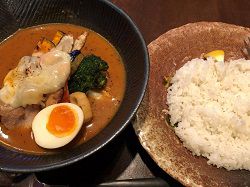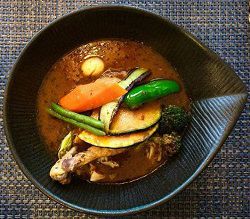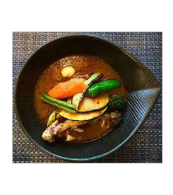Blogs edited and submitted by Chiho Kamioka
JOI Support staff and manager.
Local cuisine Sapporo soup curry
- Font size: Larger Smaller
- Hits: 2988
- 0 Comments
- Subscribe to this entry
Local cuisine in Japan
Japanese people really enjoy traveling and eating. When they travel to a certain area, then love to try the local food that is sold there, and taste the local specialties.
There is a lot of TV and magazine coverage on the different cuisine that can be found in each town, city, and prefecture around Japan. And it is rare to switch on the TV and not find at least one program introducing a local specialty or dish.
In this blog for Japanese learners, Itaya sensei a Japanese teacher at JOI, introduces a recently popular dish from her hometown on the island of Hokkaido.
Read this interesting blog, and listen to Itaya sensei reading the blog herself. It is a very good way to learn Japanese for free online.
ご当地グルメ:札幌の「スープカレー」
Local cuisine Sapporo soup curry

By ITAYA Sayuri

「ご当地グルメ」 とは、地域独特の伝統的料理だけでなく、その土地その場所の庶民に人気の料理や、たくさんの観光客に来てもらうための町おこしの一環で作られた料理などのことです。 私が住んでいる札幌は「札幌ラーメン」「ジンギスカン」「海鮮料理」など、いろいろ有名ですが、今日は近年人気になっている「スープカレー」をご紹介します。
カレーライスはインド料理を元にイギリスで生まれたそうですが、日本で独自の進化をとげ、日本の家庭料理の人気ナンバー1といっても過言ではありません。このカレーはとろみがあり、ごはんの上にかけて食べるのが通常です。

札幌スープカレーは、とろみがなく、スパイスの効いたさらさらのスープに大きな具材が特徴です。具材はスープと別に調理されているので、それぞれの素材の味が楽しめます。ほとんどのメニューでおいしい野菜がたっぷり入っています。 肉は好みで牛肉、豚肉、鶏肉、ハンバーグなど選択できます。

辛さも1~30ぐらいまでのレベルがあります。辛いのが苦手な人は1、中辛で3ぐらいだそうです。これはお店によって異なるので、注文する際に必ず店員さんに確かめた方がよさそうです。
食べ方は自由です。私がよくいく店では3つ紹介しています。
■パターンA
具材とスープカレーを一口分程度ずつライスにかけて食べる。
■ パターンB
ライスを食べてスープカレーを飲んで具材を食べるというように、ライス・スープカレー・具材別々に食べる。
■パターンC
ライスを一口分スプーンにとり、スープカレーに浸し具材と一緒に食べる。
私はだいたいパターンBです。
日本で多くの飲食店は「ごはん」のことを「ライス」と呼んでいます。これもおもしろいですね。
札幌へ来る機会があったら、地元の人もよく食べる「スープカレー」、ぜひ食べてみてください。そして札幌だけでなく、日本各地に「ご当地カレー」があるそうですから、旅行先にどんなカレーがあるのか、調べてみても楽しいかもしれません。
To listen to this blog, please watch our Youtube video.
ご当地(とうち)グルメ:札幌の「スープカレー」
「ご当地グルメ」とは、地域(ちいき)独特(どくとく)の伝統的(でんとうてき)料理(りょうり)だけでなく、その土地(とち)その場所(ばしょ)の庶民(しょみん)に人気(にんき)の料理や、たくさんの観光客(かんこうきゃく)に来(き)てもらうための町(まち)おこしの一環(いっかん)で作(つく)られた料理(りょうり)などのことです。 私(あたし)が住(す)んでいる札幌(さっぽろ)は「札幌ラーメン」「ジンギスカン」「海鮮(かいせん)料理」など、いろいろ有名(ゆうめい)ですが、今日(きょう)は近年(きんねん)人気(にんき)になっている「スープカレー」をご紹介(しょうかい)します。
カレーライスはインド料理を元(もと)にイギリスで生(う)まれたそうですが、日本(にほん)で独自(どくじ)の進化(しんか)をとげ、日本の家庭(かてい)料理の人気ナンバー1といっても過言(かごん)ではありません。このカレーはとろみがあり、ごはんの上(うえ)にかけて食(た)べるのが通常(つうじょう)です。 札幌スープカレーは、とろみがなく、スパイスの効(き)いた さらさらのスープに大(おお)きな具材(ぐざい)が特徴(とくちょう)です。具材はスープと別(べつ)に調理(ちょうり)されているので、それぞれの素材(そざい)の味(あじ)が楽(たの)しめます。ほとんどのメニューでおいしい野菜(やさい)がたっぷり入(はい)っています。肉(にく)は好(この)みで牛肉(ぎゅうにく)、豚肉(ぶたにく)、鶏肉(とりにく)、ハンバーグなど選択(せんたく)できます。
辛(から)さも1~30ぐらいまでのレベルがあります。辛(から)いのが苦手(にがて)な人(ひと)は1、中辛(ちゅうから)で3ぐらいだそうです。これはお店(みせ)によって異(こと)なるので、注文(ちゅうもん)する際(さい)に必(かなら)ず店員(てんいん)さんに確(たし)かめた方(ほう)がよさそうです。
食(た)べ方(かた)は自由(じゆう)です。私がよくいく店(みせ)では3つ紹介(しょうかい)しています。
■パターンA
具材とスープカレーを一口分(ひとくちぶん)程度(ていど)ずつライスにかけて食べる。
■パターンB
ライスを食べてスープカレーを飲(の)んで具材を食べるというように、ライス・スープカレー・具材を別々(べつべつ)に食べる。
■パターンC
ライスを一口分スプーンにとり、スープカレーに浸(ひた)し具材と一緒(いっしょ)に食べる。
私はだいたいパターンBです。
日本(にほん)で多(おお)くの飲食店(いんしょくてん)は「ごはん」のことを「ライス」と呼(よ)んでいます。これもおもしろいですね。
札幌へ来(く)る機会(きかい)があったら、地元(じもと)の人もよく食べる「スープカレー」、ぜひ食べてみてください。そして札幌だけでなく、日本各地(かくち)に「ご当地カレー」があるそうですから、旅行先(りょこうさき)にどんなカレーがあるのか、調(しら)べてみても楽(たの)しいかもしれません。
Local cuisine Sapporo soup curry
Local cuisine in Japan (or 'Gotouchi Gourmet' in Japanese) is not just the traditional cuisine that is unique to the locality, but also the food that is popular with the local people in that area and also the food made to get many tourists to visit the town, which links to the revitalization of the towns among other things.
The town in which I live in, Sapporo is famous for various food, like Sapporo Ramen noodles, Jingisukan (Genghis Khan) lamb dishes, and seafood cuisine etc, but the food I want to introduce today is Soup Curry which has become popular in recent years.
Japanese style curry rice was originally an Indian dish that was first started in England and developed in a way peculiar to Japan and it would not be an exaggeration to say that it is has become the number one most popular home cooking in Japan. This curry has a thickness to it and is usually eaten poured over some rice.
Sapporo's soup curry does not have a thickness to it but is free-flowing soup which features large ingredients in it. The ingredients are prepared separately to the soup, so you can enjoy each of the tastes of the ingredients. Most of the recipes include ample servings of delicious vegetables.
You can choose the meat to your liking from beef, pork, chicken or hamburger steak among others. You can select the level of spice from 1 to about 30 too. For people who don't like spicy food, there is level 1, and mildly spicy is level 3. But this depends on each shop, so apparently, it is always a good idea to confirm with the shop staff when you order.
You can eat it in any way you like. Let me introduce you to three ways used in the shops that I often go to.
■Pattern A
You pour one mouthful of curry and ingredients over some rice and eat it this way.
■ Pattern B
You eat the rice, then drink the soup and then eat the ingredients so that the rice, soup and ingredients are eaten separately.
■Pattern C
You pick up a mouthful of rice with your spoon, dip this into the soup curry, and then eat it together with ingredients.
I usually use Pattern B.
In many restaurants in Japan, the Japanese 'gohan' (rice) is often called 'raisu'. This is interesting as well, right? If you get a chance to come to Sapporo, please try this soup curry which the local people often eat as well. And it is not just Sapporo, there are apparently local cuisine curries in various places around Japan, so it might be fun to check out what types of curry there are in each local destination that you travel to.
ご当地(とうち)グルメ: local cuisine; popular food from a particular area
スープカレー: curry soup with rice (wasei: soup curry)
地域(ちいき): area; region
独特(どくとく): peculiarity; uniqueness; characteristic
伝統的(でんとうてき): traditional; conventional
庶民(しょみん): common people; ordinary people
観光客(かんこうきゃく): tourist
町(まち)おこし: revitalization of a town; town renewal (project)
一環(いっかん): link (e.g. in a chain of events); part (of a plan, campaign, activities, etc.);
海鮮(かいせん): seafood
近年(きんねん): recent years
元(もと): origin; source
独自(どくじ): original; unique; distinctive; characteristic; peculiar
進化(しんか)をとげる: to make progress; to develop; to evolve (method, style, etc.)
過言(かごん): exaggeration; overstatement; saying too much
とろみ: thickness (e.g. of a sauce, oil, etc.); viscosity
通常(つうじょう): usual; ordinary; normal; regular; general; common
効(き)く: to be effective; to show effect
さらさら: (1) rustling; murmuring; (2) fluently; (3) silky; smooth and dry; free-flowing
具材(ぐざい): material; ingredient
特徴(とくちょう): feature; trait; characteristic
調理(ちょうり): cooking; food preparation
素材(そざい): ingredient; (raw) material; resource
選択(せんたく): selection; choice; option
辛(から)さ: spicy taste
~によって異(こと)なる to differ depending on ...
際(さい): on the occasion of; circumstances
確(たし)かめる: to ascertain; to check; to make sure
一口(ひとくち): mouthful; morsel; bite
程度(ていど): degree; amount; grade; about
別々(べつべつ): separately; apart; severally; individually
浸(ひた)す: to soak; to dip; to steep; to immerse
飲食店(いんしょくてん): restaurant
機会(きかい): opportunity
地元(じもと):home area; home town
各地(かくち): every place; various places
Hajimemashite, everyone. My name is Itaya Sayuri. I live in Sapporo, Hokkaido.
Sapporo is a really liveable city because, although we have a lot of snow in the winter, the summers are much cooler than other areas of Japan. Apart from teaching Japanese, I also hope to let everyone know about Sapporo, its beautiful nature and delicious food.
I play volleyball once or twice a week for my health and play golf on occasion. I also love watching movies.
Do you think the Japanese language is difficult? Well, come and enjoy studying with me in our online Japanese classroom?don't worry about making mistakes and just try to speak up as much as possible. I think this is the secret to success in Japanese. Ganbare!



